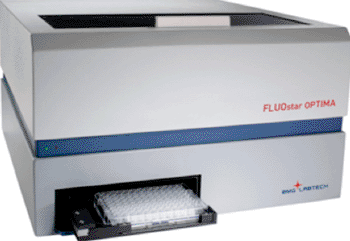Gene Discovery Illuminates Cause of Bone Marrow Failure
By LabMedica International staff writers
Posted on 04 Mar 2014
A novel genetic defect has been identified among patients with bone marrow failure, which could reveal its underlying cause.Posted on 04 Mar 2014
Bone-marrow-failure syndromes, such as fanconi anemia, dyskeratosis congenita, and aplastic anemia, are a heterogeneous group of life-threatening disorders characterized by the inability of the bone marrow to make an adequate number of mature blood cells.

Image: The FLUOstar Optima plate reader (Photo courtesy of BMG Labtech).
Scientists at the Queen Mary University of London (UK) and their colleagues chose three genetically uncharacterized index cases from their repository of bone-marrow-failure case. They performed exome sequencing with the aim of identifying variants in a common gene. The three had trilineage, erythroid, myeloid, and megakaryocytic, bone marrow failure and came from consanguineous families. All three also had developmental delay characterized by learning disability, and two out of the three cases also had microcephaly.
Peripheral-blood samples were obtained from the three patients and DNA extracted. Various other techniques were used in the study including, histology and immunohistochemistry, immunocytochemistry, imaging, and colocalization studies, real time polymerase chain reaction (PCR) and immunoblotting densitometry and small interfering ribonucleic acid RNA (siRNA) studies. For the evaluation of basal reactive oxygen species (ROS), cells were labeled with ROS marker dihydroethidium and the fluorescence was measured by flow cytometry. Real-time changes in ROS fluorescence after treatment were measured with the use of a FLUOstar Optima plate reader (BMG Labtech; Ortenberg, Germany).
Exome sequencing revealed that two of the three cases studied with bone marrow failure and developmental delay had homozygous truncating variants in the gene Excision Repair Cross-Complementing Rodent Repair Deficiency, Complementation Group 6-Like 2 (ERCC6L2). This ERCC6L2 mutation links a distinct bone-marrow-failure syndrome to DNA repair and mitochondrial function. The findings mean it is now possible to carry out a reliable genetic test, including antenatal testing, in these families and get an accurate diagnosis. In the long term, with further studies, the findings could lead to the development of new treatment for this specific gene defect.
Inderjeet Dokal, MD, a professor of pediatrics and child health, and the senior author of the study said, “New DNA sequencing technology has enabled us to identify and define a new gene defect which causes a particular type of bone marrow failure. This is a promising finding, which we hope one day could lead to finding an effective treatment for this type of gene defect. Clinicians treating patients with bone marrow failure should now include analysis for this gene in their investigation.” The study was published on February 6, 2014, in the American Journal of Human Genetics.
Related Links:
Queen Mary University of London
BMG Labtech













